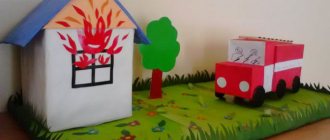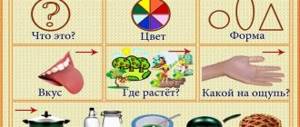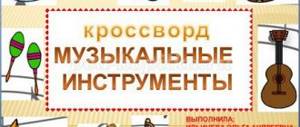Conversation with older children about music
Summary of a conversation with children of senior preschool age on the topic “Lullabies of Russian composers”
Author: Natalia Valerievna Konduktorova, teacher of the Balashikha city district MBDOU “Kindergarten of a combined type No. 20 “Teremok”
This development is intended for teachers of preschool educational institutions and primary school teachers. The material will also be of interest to students of Pedagogical Colleges and higher educational institutions who are interested in the methods of musical education of preschool children. The conversation explores the origins of the word lullaby; examines lullabies in the works of Russian composers: P. I. Tchaikovsky, A. K. Lyadov. Goal : Formation of musical and aesthetic culture in children Objectives: 1. Develop children's musical perception. 2.To form children’s ideas about the work of Russian composers using examples of vocal lullabies. Preliminary work: Making the “Magic Book” of the Music Fairy. Materials and equipment: 1. Music center. 2. Disc with recordings of lullabies by P. I. Tchaikovsky (“Lullaby in a storm” to the verses of A. Pleshcheev, “Lullaby song” to the verses of A. Maykov.) 3. “Magic book”, including the following pages: - image of the cradle with a singing mother; — portrait of P. I. Tchaikovsky; — Surikov’s landscape “Before the Storm”; - image of a sleeping child in a cradle; - portrait of A.K. Lyadov. Progress of the conversation: Educator: Children! Look, I have the “Magic Book” in my hands. The Music Fairy sent it to us so that we could get acquainted with the lullabies of Russian composers. The fairy told me that this “Magic Book” has unusual pages; if you open them slightly, amazing music will sound. First we will open the first page. What do we see? (Children's answers)
Correct!!!
The fairy drew a cradle in which the baby is sleeping, and next to it a mother singing a lullaby to her child. Do you know what the word “lullaby” means? And how long have lullabies been around? (Children's answers.)
The name “lullaby song” comes from the words “cradle”, “to swing”, “to swing”.
And in popular usage there was another name for lullabies - tales (from the verb “bakat”, “cradle”, “rock”, “put to sleep” or bayat - “talk”, “say”.) A story was used to persuade the child to fall asleep quickly. The lullaby, having been born as a folk song genre, was developed in the works of Russian composers. What Russian composers do you know? (Children's answers)
Let's turn the page in our “Magic Book” and find out what else the Music Fairy wants to tell us. On the second page we see a portrait of P. I. Tchaikovsky. Yes, this Russian composer owns lullabies, both vocal and instrumental. His lullabies are very similar to folk ones.
Turning the second page, do you hear the music?
It sounds like a sad and alarming melody, unusual for lullabies. The music is so sad and gloomy, evoking a whole range of feelings - anxiety, a desire to calm the child. This lullaby was written by P. I. Tchaikovsky to the verses of A. Pleshcheev in inclement weather and was called “Lullaby in a Storm.” Look at how the storm is depicted in The Magic Book. This fantastic night gloomy landscape, depicted by the artist Surikov, evokes the same feelings as “Lullaby in a Storm.” How does this landscape and this music make you feel? (Looking at illustrations)
In addition to “Lullaby in a Storm”, P. I. Tchaikovsky has another “Lullaby” based on poems by A. Maykov, which is more like a folk song.
Let's take a look at the "Magic Book" again. Do you hear a soothing, soft, kind lullaby? This affectionate melody of a mother for her child. How do you think Tchaikovsky’s lullabies are similar and how they differ? What feelings does the lullaby to the verses of A. Maykov evoke? (Children's answers)
Let's turn the page in our book and see that the Music Fairy has painted another portrait. This Russian composer's name is Anatoly Konstantinovich Lyadov. There are also many lullabies in his work. For example, in Lyadov’s orchestral miniature “Kikimora,” one of the fairy-tale heroines, Kikimora, is engaged, as they believed in the old days, in spinning fabric and yarn. From morning to evening, Kikimora is entertained by Kot-bayun. He tells overseas tales and rocks Kikimora in a crystal cradle. The Bayun cat sings a gentle, soothing lullaby, under which Kikimora herself can be heard sobbing. At the end of the introduction, the cold heavenly sounds of the celesta appear, like the ringing of a “crystal cradle”.
Next time we will listen to this lullaby and lullabies of other Russian composers: Rimsky-Korsakov, Shostakovich, Mussorgsky, Arensky.
The “Magic Book” of the Music Fairy introduced us to such beautiful lullabies of Russian composers. Bibliography. 1. Radynova O.P., - Bayushki - Bayu: We listen and sing lullabies. – M.: VLADOS, 1995 – 296 p. 2. Maryina E. S., Nagornykh G. V. The genius of music // Read, learn, play. – 2010, No. 2.
We recommend watching:
Scenario of sports leisure “Small Children's Olympic Games” in the senior group Scenario of the sports festival “Dad, Mom, I - a sports family” for children of the senior group with their parents Physical education leisure in the senior group of the kindergarten. Scenario: Leisure according to traffic rules in the senior group
Similar articles:
Book name day in kindergarten. Scenario
Scenarios for holidays in the senior group of kindergarten
Physical education leisure in the senior group “Hello, Zimushka-Winter”
Physical education leisure in the senior group in kindergarten “Journey to the Land of Health”
Abstract of educational activities for cognition in the senior group of kindergarten on the topic “In the village”
A series of conversations about music for children of senior preschool age: Camille Saint-Saens “Carnival of the Animals”
A series of conversations about music for children of senior preschool age
Camille Saint-Saens "Carnival of the Animals"
Target:
talk about the composer C. Saint-Saens; learn to distinguish the nature of a musical work, develop the ability to understand the emotional content of a musical work, speak out about the work, develop the ability to convey various musical images in motion.
First conversation.
Teacher
: Guys! Who knows what a carnival is?
Children
: A holiday when everyone wears masks and costumes.
Teacher
: Right. A carnival is a party where all participants dance in costumes and hide their faces under masks. It turns out that animals also organize a carnival. This is an unusual carnival. It is musical. The music for the carnival was written by composer Camille Saint-Saens.
Teacher
shows a portrait of the composer.
Camille Saint-Saens lived in France. When Saint-Saens was 2 years old, he began to learn to play the piano. At the age of 6, Camille Saint-Saëns tried to compose music himself, and at the age of 10 he was already giving his first concerts. Saint-Saëns was interested in various sciences. He wrote poetry, played the organ very well, loved animals and studied them. He wrote music about animals. The music album is called “Carnival of Animals”.
Let's listen carefully and try to guess who came to the animal carnival first.
Teacher
puts on "March of the Lion"
Teacher
: What is the character of the music? (Serious solemn)
Teacher
: What instruments did you hear (piano or piano)
Teacher
: Have you guessed who is hiding in this music? Children express their guesses.
Teacher
: A lion comes to the carnival and leads a little lion cub
Let's listen to the music again.
Re-listening
Teacher
: Who heard the growl in the music?
What kind of instrument do you think represented the growl?
(piano)
How did Saint-Saëns show with music the lion cub's entrance? (melody is the same as
a lion, only higher)
This play is called "March of the Lion".
Why do you think this is a march? (you can walk and march under it)
What is the tempo of the march? (calm)
How does a lion come out to music? (proudly, majestically slowly) Imagine that you are lions. I will turn on the music again, and you will pretend to be lions to the music. Remember that growls are in music. So that everyone can hear him, we will show the lions only with movements.
The “March of the Lion” sounds and the children perform the movements.
Teacher
: We are returning from the carnival to the kindergarten. The children return to their seats.
Teacher
: Who did we see today? What was the lion like?
What is the name of the composer who helped us go to the carnival?
animals?
Several more animals live in the music album “Carnival of Animals”. We'll meet them next time.
Second conversation.
Teacher
: Today we will solve another mask at the music carnival. Who did we hear last time? (lion, march of the lion)
The musical album “Carnival of the Animals” by Saint-Saëns takes us on a journey. Guess the riddle and find out the next mask at the carnival.
There is an animal at the carnival
He carries a wallet in his bag,
Agilely jumps long
Australian
Children: Kangaroo.
Teacher
: Listen to how the kangaroo is having fun at the carnival.
Teacher
puts on the musical play "Kangaroo".
Teacher
: What does a kangaroo do in music? (jumps, jumps,
jumps)
The kangaroo jumps and freezes, as if turning its head. How does music convey the movements of a kangaroo? (there are pauses, slowdowns, stops in the music)
What instruments did you hear? (piano)
This piece is performed by pianists on two pianos simultaneously.
Now we will listen to another piece. It is also performed
two pianists on the piano. The play is called "Antelopes".
Teacher
puts on the musical play "Antelopes".
What is the tempo of the music? (fast, lively)
How does the music of antelopes and kangaroos differ? (there are no pauses or stops)
Antelopes run swiftly and quickly. There are no pauses in the music.
When listening again, the teacher offers a game:
Option 1: Now our hands will turn into kangaroos, then into antelopes. When you hear kangaroo music, our hands will bounce on our knees. During pauses, turn your head. During the music, the antelopes' fingers will quickly run along their legs. Two plays by Saint-Saëns are played in turn: “Kangaroos” and “Antelopes”. Children perform appropriate movements.
Option 2: Take paper and pencils. When the music starts, draw it with lines.
Children draw while musical pieces are playing.
Teacher
: Guys, let's see what lines we got to the kangaroo music. They are different from the antelope lines. Why?
Well done! Everyone heard and guessed the animals under the musical masks. Next time we will open another mask at the carnival.
Conversation three
.
At the carnival, all the animals are having fun and dancing. The fish really wanted to come to the carnival. Can fish dance on land? (no, they don’t have legs, fish live in water, they can’t breathe on land) Saint-Saëns came up with a trick for the fish. He placed the fish in an aquarium. And the fish were able to watch the carnival. Let's listen to the music of Saint-Saëns "Aquarium". Music is playing.
What is the tempo of the music? (slow, calm)
What kind of music suits your mood? (tender, affectionate, transparent, dreamy)
Sit comfortably, close your eyes and listen to the music again. Rehearing.
Who heard what in music? (children tell their fantasies)
Teacher
connects children's sentences into a story: Small fish swim first to one side of the aquarium, then to the other. Swirling around the algae. The seaweed is swaying. The fish blow air bubbles. The water is splashing. Night falls and the inhabitants of the aquarium fall asleep.
Now we will imagine that we are small fish and algae in an aquarium. Let's split up in pairs. Agree who will be the fish first and who will be the algae. During the music, you will switch roles. The fish take the ribbons, and the algae take the plants. The algae squat down and sway gently to the music, and the fish swim around. Listen carefully to the music. You yourself will switch roles when you feel the right moment.
A musical play is being staged. Children move to the music, changing roles, in accordance with musical perception.
Fishes and algae, return to your places. Who were you at the carnival today? Did you like it?
Conversation four.
On the wall of the group there are photographs of a lion, kangaroo, antelope, and an aquarium with fish. One frame is empty. Prepared squares of 2/2 colored paper and glue.
Teacher
: Guys, look at the exhibition we have on the wall. Where do you think all these animals come from? (from Animal Carnival) One photo is missing here. The music will tell you which one.
Listen to "Finale" from the music album Carnival of the Animals by Saint-Saëns. "Final" sounds.
What is the mood of the music? (cheerful, playful, perky, mischievous, funny, jumping, dancing)
What's the pace? (fast, frisky)
Who performs this music? (orchestra)
Did you recognize any instruments from the orchestra?
Who do you think dances to this music?
All the carnival animals are dancing here, but everyone can be heard. Let's listen to the music again. Rehearing.
What animals did you hear in the music? (children say who heard who)
What animal would each of you like to turn into? Choose one image for yourself and show me its movements, and I will try to guess.
Game "Show without words."
Teacher
, having guessed all the riddles: What photograph is missing from our exhibition? (where everyone is dancing)
Let's take a photo of the group dance. Everyone turns into their own animal, I'll take the camera and turn on the music.
The music turns on. Children perform their animal's dance to music. The teacher takes photographs.
Teacher
: Guys! Our photo will be printed in the salon within 2 days. So that our frame does not hang empty, let's make a picture now. This will be a picture of the musical mood. In front of you are squares of different colors. Each person choose a square of a color that matches the mood of the music (the play “Final” is turned on). Glue the squares on a white sheet to the music. Glue your squares without leaving any white color (it turns out to be a mosaic picture, the teacher inserts the picture into the frame). What is the mood of our picture? Why?
In the group, in the music corner, an album is posted with photographs of the composer, animals - participants in the musical carnival, and a general photograph. Children can use this album in independent activities with musical instruments and listening to audio recordings.
A series of classes on listening to music in the senior group on the theme of P.I. Tchaikovsky "Waltz of the Flowers". Lesson 1.
Summary of a lesson on listening to music in the senior group
P.I. Tchaikovsky "Waltz of the Flowers"
Lesson 1.
Subject:
P. I. Tchaikovsky “Waltz of the Flowers” (initial and repeated listening to music).
Program content:
Educational objectives:
— continue to introduce children to the music of Russian composers (Pyotr Ilyich Tchaikovsky);
— learn to tune in to the perception of music while listening.
Developmental tasks:
- develop creative imagination through listening to music.
Educational tasks:
— to cultivate in children an interest in music and a desire to listen to it;
— develop cultural listening skills;
— to teach children to respond emotionally to music.
Preliminary work:
observing flowers and trees on the site, reading poems about flowers, looking at postcards, photographs depicting garden and wildflowers, drawing spring flowers; acquaintance with Russian folk crafts, the basis of which ornaments are motifs of various colors; listening to the music of P.I. Tchaikovsky “Snowdrop”, “Lilac Fairy”.
Equipment:
music center, disc P.I. Tchaikovsky “The Seasons”, portrait of P.I. Tchaikovsky, color photographs and postcards with spring, garden and wildflowers, pencils, sheets of white paper, dance paraphernalia (gymnastic ribbons, flowers).
Methods and techniques:
verbal
(
conversation), visual (demonstration of a portrait of the composer, color photographs and postcards with flowers, illustrations for the dance “Waltz of the Flowers” from the ballet “The Nutcracker”), practical (drawing based on a performance, dance).
Duration:
30 minutes.
Progress:
- Introductory part.
Educator: Guys, tell me what time of year it is?
Children: Spring.
Educator: That's right, guys! What happens to nature and plants in spring?
Children: nature awakens, the first flowers appear, buds bloom on the trees, fruit trees (plum, cherry, apricot, cherry, almond) bloom.
Educator: What were the first flowers you saw on our site?
Children: Yes! Primroses. And also green grass, buds on trees and flowers on tree branches.
- Main part.
Educator: Guys, today we will listen to a fragment of Pyotr Ilyich Tchaikovsky’s “Waltz of the Flowers”. Pyotr Ilyich Tchaikovsky is a great Russian composer who created many works of classical music, including various operas and ballet performances.
Demonstration of a portrait of the composer.
We have talked a lot about the fact that ballet is a large work consisting of different dances. “Waltz of the Flowers,” which we will now listen to, is an excerpt from the ballet performance “The Nutcracker.” There is also a lot of dancing in the Nutcracker ballet. We have already covered what a waltz is. That's right, this dance is light, whirling, paired. Like all waltzes, it sounds tender, swirling in flowers. Look at the illustrations: what beautiful and expressive poses the dancers have, soft expressive hands!
Display of illustrations for the dance “Waltz of the Flowers” from the ballet “The Nutcracker”.
When you listen to this music, try to imagine this dance of flowers - a waltz. What flowers will you see?
Display of color photographs and postcards with flowers.
How do flowers dance? How do they look? What are they doing? Or it won't be flowers. What then? While listening to music, pay attention to what you feel, what you imagine? What's your mood? And after listening to the music, we will share our impressions with you!
An excerpt (2-4 minutes) from the work “Waltz of the Flowers” is played.
Educator: Guys, what is the name of the piece you just listened to?
- "Waltz of the Flowers".
- Right. Who is the author of this work?
- Peter Ilyich Tchaikovsky.
Educator: That's right, well done!
This waltz has a big introduction. What musical instrument is the main one in this passage? This is a harp. Why do you think the composer chose this particular musical instrument for the Waltz of the Flowers? What musical instruments would you choose for this dance? What is the character of the music? What's your mood?
Children's answers. The teacher asks those who do not answer questions together with everyone else separately.
Educator: Guys, now let's sit down at the tables. Let each of you remember the music that we listened to today, and try to draw what you imagined while listening to the work of P.I. Tchaikovsky "Waltz of the Flowers".
Children draw. Children's drawings are hung on the board.
Educator:
In his musical work P.I. Tchaikovsky depicted a fairy-tale meadow with dancing flowers. Let's also spin with the fairy tale heroes in a magical waltz of flowers.
Children choose their own attributes (gymnastic ribbons, flowers) and dance freely to the music of the “Waltz of the Flowers.”
3. Final part.
Educator: Children, how beautifully you danced! But our lesson has come to an end. Tell me, what did you do today?
Children: Listened to music, looked at pictures, drew, danced to the music.
Educator: Did you like the lesson and what did you like most? Today we fantasized to the music of P.I. Tchaikovsky "Waltz of the Flowers". Let's look at your drawings, how beautiful they turned out! What different flowers did you imagine! What works do you like best and why?
Children's answers:
Kolomytseva Nastya:
I liked dancing to music and drawing. I drew flower fairies. They are light, airy, they fly from flower to flower and the result is a dance.
Lipartia George:
I liked the music we listened to today. I liked drawing. I have flowers in my drawing: roses, tulips. They are dancing.
Petrosyan Marat:
I drew a clearing with flowers.
Educator:
Let's think about how and what can be decorated with such beautiful drawings (a playroom, a bedroom in a kindergarten, your room at home)?
Images of spring flowers.
Illustrations. Dance "Waltz of the Flowers" from the ballet "The Nutcracker".
Self-analysis of music listening in the senior group
Both activities were focused on listening to music. During the classes, the following tasks were solved: to introduce children to the music of Russian composers, to teach them to tune in to the perception of music while listening, to listen carefully, memorize and recognize music; develop creative imagination through listening to music and musical-rhythmic movements; to cultivate in children an interest in music and a desire to listen to it, etc.
What was done well
: The guys listened to the music carefully. We remembered the composer and named him correctly in the second lesson. They knew the difference between the waltz and other types of dances, and were able to characterize the music of the waltz - gentle, light, whirling. The children enjoyed imagining and drawing after listening to the music. Most of the children drew flowers. We twirled in the waltz-improvisation with great pleasure, especially the girls, and played a musical game. Some boys were more restrained in expressing emotions and movements. Listening to music and playing games evoked positive emotions and pleasure in children. The use of gaming techniques during work helped prevent children from being overloaded and activated their attention and interest.
Difficulties:
It was difficult for the children to identify by ear the musical instruments sounding in the waltz. It was difficult for me to convey information about the composer and music to the children correctly and in an accessible form. The music worker helped me a lot with this. It was quite difficult to simultaneously hold the attention of the children, provide them with information, prepare attributes and equipment for listening to music and viewing slides, and maintaining discipline in the group. Thanks to joint efforts with the teacher and music worker, both classes were conducted at a fairly high level. According to the children's feedback, they liked both activities.




